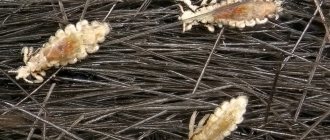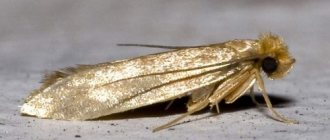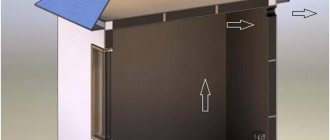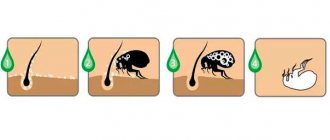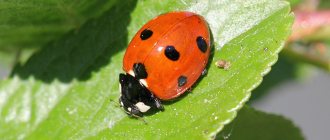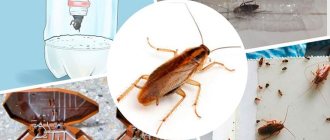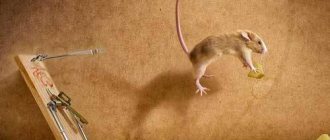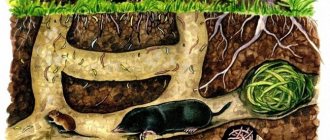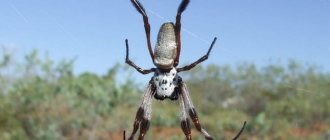What does a locust look like?
Migratory (Asian) locust (Locusta migratoria)
The locust is a large insect with an elongated body 1–6 cm long, some species grow up to 14 cm. In appearance, the pest resembles a grasshopper .
The pest has a large, not very mobile head and large eyes. The insect's antennae are shorter than those of other members of the family. The chest is covered with dense hairs.
The color of the integument performs a camouflage function and depends on the environment and developmental phase. Single males and females are bright green, brown-olive, gray with small spots. In the gregarious form, all insects have the same color and are similar to each other.
Of the 6 legs, the front legs are the weakest, the hind legs are bent at the knees, they are longer than the middle and front legs. The insect's wings are translucent, covered with hard elytra and invisible when folded.
The locust has a powerful jaw, which allows it to chew not only soft, but also hard food . The pest gnaws out leaves and stems with its upper mandibles and crushes them with its lower mandibles. The insect does not feed on flower nectar.
There are special notches on the thighs of males, and thickenings on the elytra. When they rub in flight, the insect makes specific creaking sounds. When a swarm of locusts flies, these sounds turn into a strong roar , similar in power to thunder.
Insect eggs are 6–8 mm long and resemble grains in color and shape. The larvae look like adult locusts. The color of the gregarious form is variegated, single larvae are most often green.
Green, grasshopper-like
Very often, inexperienced summer residents mistake the most common grasshopper (not just harmless, but even useful) for the most terrible pest of fields and gardens - the locust. The explanation is simple: green grasshoppers look very similar to the harmless grasshopper locust. It is very easy to distinguish these insects:
- the grasshopper is active at night, the locust during the day;
- the grasshopper hunts small insects, the locust hunts only plants;
- The grasshopper has long legs and whiskers, the locust has a longer abdomen.
Features of the life of a pest
Italian locust (Calliptamus italicus)
Locusts are widespread everywhere, with the exception of cold climate zones. The family has over 10,000 species. In our country, the migratory (Asian) locust (Locusta migratoria) , the Italian locust (Calliptamus italicus) the Moroccan locust (Dociostaurus maroccanus) in the south . Some species live near rivers in dense thickets of grass, others in arid and rocky areas overgrown with sparse bushes and grass.
In adult insects, there are 2 stages: solitary and gregarious. Single individuals (fillies) live separately, they are inactive and feed on moderate plant foods. One such locust eats 300 g of food during its life.
Having gathered in a flock, the insect becomes voracious . It devastates grain fields and gardens and eats its weakened relatives.
The development of the pest is incomplete. After fertilization in the summer, the female lays 50–150 eggs, protected by an egg capsule, . Depending on the species, the female lays 1–18 egg capsules during her life.
The walls of the cocoon are thin and soft, consisting of a mixture of brown insect secretions and particles of earth. After the end of oviposition, the adults die, and the eggs overwinter in a capsule. In the spring, the eggs burst and larvae emerge from them. They look like adult insects, but without wings.
The larva develops in 30–50 days, in the southern regions it takes 14–16 days, and during this time 5 instars pass, accompanied by molting. After the last molt, the locusts develop wings. Depending on the species, the insect lives 8–24 months.
Situation
According to survey data, as of June 15, 2017, 826.75 thousand hectares were infested with the pest. In total, 377.46 thousand hectares were treated against the pest in the Russian Federation.
Current information on locusts in the Russian Federation as of 06/15/17
| Region | Surveyed, thousand hectares | Inhabited, thousand hectares | Processed, thousand hectares | Involved in processing ground equipment, pcs. | Involved in aircraft processing, pcs. |
| Total for the Russian Federation, incl. | 4481,948 | 826,746 | 377,46 | 243,00 | 35,00 |
| Central Federal District, incl. | 133,600 | 15,486 | 0,000 | 0 | 0 |
| Southern Federal District, incl. | 1469,242 | 112,135 | 77,24 | 85,00 | 6,00 |
| North Caucasus Federal District, incl. | 1234,919 | 359,975 | 294,167 | 142 | 29 |
| Volga Federal District, incl. | 413,628 | 41,808 | 0,000 | 0 | 0 |
| Ural Federal District, incl. | 157,538 | 51,176 | 0,000 | 0 | 0 |
| Siberian Federal District, incl. | 1014,036 | 220,596 | 6,050 | 16 | 0 |
| Far Eastern Federal District, incl. | 58,985 | 25,570 | 0,000 | 0 | 0 |
A state of emergency has been introduced in three districts of the Stavropol Territory and in three districts of the Republic of Dagestan. The high alert regime is in the Republic of Kalmykia and in the Limansky district of the Astrakhan region.
Information on emergency situations regarding locust pests in the constituent entities of the Russian Federation as of June 15, 2017
| Subject | Processed in 2021, thousand hectares |
| In the Republic of Kalmykia on May 16, 2021 by Order of the Government of the Republic of Kalmykia. No. 162-the “High Alert” regime was introduced on the territory of the republic. | 76,13 |
| In the Stavropol Territory, on May 28-29, 2021, an “Emergency Situation” regime was introduced in the territory of 3 administrative districts: Arzgirsky, Levokumsky, Neftekumsky. | 269,3 |
| In the Republic of Dagestan, a state of emergency was introduced in three districts - Kizlyarsky, Tarumovsky, Nogaisky. From June 14, 2021, a state of emergency is expected to be introduced throughout the entire Republic of Dagestan. | 16,6 |
| From June 9, 2021, a “High Alert Mode” for locust pests was introduced in the Limansky district of the Astrakhan region. | 0,0 |
Particularly dangerous, gregarious species have been discovered in southern Russia: Asian and Moroccan locusts. The Italian locust is also considered dangerous - all of them can migrate over significant distances in a short period of time and cause enormous damage to crops.
Why do the locusts come?
Moroccan locust (Dociostaurus maroccanus)
For a long time, the reasons for the appearance of locusts were not clear to people. Why in some years did safe and modest single individuals gather in flocks of millions and turn into pests of mass destruction over thousands of square kilometers?
At first it was believed that such temporary mutations occur during dry seasons, when most vegetation quickly burns out and there is less food for the insect. But the facts contradict this. The formation of a flock occurs not only in hot years and when there is an abundance of food.
Scientists' latest discovery is that hordes of locusts appear not due to hunger, but due to a lack of protein in food . This leads to cannibalism among them. Some insects attack their protein-rich relatives.
Fearing being eaten, single individuals (fillies) gather together. The gregarious form most often forms in river floodplains. Seeing many relatives nearby, a “marching” program is launched in the insect’s body.
The offspring from the laid eggs appear already programmed to search for food . For about 2 weeks after birth, young insects remain in one place. The signal for migration is population density. As soon as a critical mass accumulates and all the vegetation around is eaten, the army of the pest goes in search of a better habitat.
At first, insects walk on foot, since there are no wings yet. They move quickly in orderly rows, crossing even wide rivers. Many walking locusts die in this case, but this decline does not seriously affect the herd. After several molts, the pest increases in size - muscles and wings grow. They become larger and lighter than single individuals.
The locusts are becoming more aggressive and voracious. Scientists believe that solar activity also affects the aggressiveness of the pest. Having spread its wings and risen upward, the locust then moves through the air.
The flock flies at a speed of 10–15 km per hour and can cover 80–120 km per day .
The pest eats everything in its path, but as soon as they accumulate a sufficient supply of protein, the locusts again turn into peaceful insects, and the formidable swarm disappears.
Creation of a dangerous “group”
In the past, farmers did not understand why the humble, solitary insects gathered in large swarms. This transformation of locusts into a dangerous pest seemed an incomprehensible phenomenon and even “God’s punishment.” Over time, scientists have discovered several reasons. One of them is a lack of amino acids and organic substances in the body. This occurs during dry periods when there is a lack of food. Females lay as many eggs as possible, and they develop an acute gluttony. Hot weather also influences particular activity and aggression.
Insects mercilessly devour grain crops:
- wheat;
- rye;
- oats;
- barley.
They do not pass by corn, sunflower, buckwheat, rice, soybeans, flax and hops. Swarms of locusts attack clover, alfalfa, and vegetable crops. They cope with fruit trees and berry bushes. First, the “army” marches “on foot.” But over time, the individuals, spreading their wings, move through the air. The movement speed reaches 15 km/h. In a day, the “flock” is capable of covering about 120 km, destroying all the greenery on its way. The procession continues until the individuals accumulate a sufficient amount of protein. After this, they regain the status of peaceful insects.
What plants does the pest attack?
Locusts are omnivorous . Moving through the fields of large farms, it destroys grain plantings: wheat, rye, oats, barley . It gnaws the ears and eats unripe grains.
Damages crops of rice, millet, sorghum, corn, buckwheat, sunflower, hops, flax, soybeans . Swarms of locusts attack pastures and haylands where alfalfa, clover and other grasses grow.
On farm and private plots, locusts feed on potatoes, beets, cabbage, rutabaga, pumpkins and legumes . The pest can cope with young fruit trees, forest trees and shrubs .
Locusts eat their bark.
A locust is not a grasshopper!
Locusts must be combated. But before you take up the sprayer, you should correctly identify the pest, because the insect that you mistook for a dangerous locust may turn out to be a harmless grasshopper. Grasshoppers also belong to the order Orthoptera. But if the locust feeds on vegetation, the grasshopper is a predator. It destroys harmful insects, so it is a welcome guest on the site.
Differences between a grasshopper and a locust:
Even an adult grasshopper cannot fly - this is its main difference from locusts.
Methods of locust control in large farms
Not only farmers themselves, but also government services are involved in the fight against locusts. In the regions, special centers monitor locusts, make forecasts for the spread of the pest, determine affected areas and control methods . Their task also includes mandatory informing agricultural producers about the results obtained.
Farmers, for their part, must regularly assess the phytosanitary condition of their fields. Currently, the most effective and fastest methods of control in large farms is the use of pesticides .
Spraying is carried out from small aircraft at low altitude or on the ground using wide-cover sprayers . It is important to carry out these treatments on time - until the locusts take wing. Adults are resistant to poisons, and larvae of 3–4 instars can be successfully destroyed with insecticides. Large farms use pesticides: Image, Dimilin, Gladiator KE , etc. Additional control measures are autumn harrowing, cultivation and peeling of the soil .
Ways to fight
If there is a threat of locust invasion, protective actions must be taken immediately.
If the activity of insects is noticeable to the naked eye, then you need to immediately resort to the most severe forms of exposure.
For each specific case, you can choose the optimal strategy:
Mechanical cleaning
Collection and destruction of pests is possible only if several representatives of this species are detected. You can also stop the spread early by selecting larvae from moist soil. This is especially true if August turns out to be warm and rainy. Also at risk are areas located near natural reservoirs and lowlands.
Digging
Such measures will help in finding larvae, but are not always possible. Often, during an invasion, such measures do not produce results at all, since some of the larvae remaining in the ground manage to quickly grow into a full-fledged individual, which is impossible to keep up with. This technique becomes more effective if, in addition to loosening the soil, specialized solutions and preparations are introduced into it to combat clutches and larvae. It is better to carry out such an impact in the preparatory period, especially if the previous season was marked by infestations of this pest.
Burning cereal residues
Such an impact makes it possible to burn out clutches of parasites that are located close to the surface of the soil, but if the larva lies deeper than 5 cm, the thermal effect will not play a significant role.
Sometimes, for greater heat, the area is additionally sprinkled with peat and straw, which will increase the depth of heating. Often this technique is used in large fields, especially if the pest has been found in nearby areas.
For greater efficiency, the soil is dug up after burning the dry tops, so winter frosts will help destroy the remaining insects that have taken refuge in the depths.
Chemical treatment
Modern industry can offer a lot of different products for pest control, and locusts are no exception. In gardening stores you can choose a composition that will take into account all the necessary conditions. But it is worth considering that chemical treatment negatively affects the quality of products. To minimize damage, it is necessary to carry out preventive work in early spring before sowing. Select a soil treatment agent to prevent the appearance and development of larvae, and when migratory pests appear, less chemicals will be needed to control them.
When working with chemicals, it is very important to choose an effective method of exposure. Adult locusts are quite resistant to chemicals and are difficult to treat with poisons, so it is most effective to spray plants. This treatment must be carried out carefully, because the parasite feeds on all parts of garden crops.
But even the strongest chemicals cannot completely protect garden crops from the attacks of parasites. Therefore, for maximum effect it is necessary to use a set of preventive, protective and countermeasures. This combination of approaches will reduce the harm that locusts cause to agriculture and prevent the reappearance of garden pests next season.
You shouldn’t expect that the locusts will be completely removed, and you definitely shouldn’t hope for quick results. Getting rid of the invasion should take place gradually and with careful study of all stages. Locusts are not a death sentence, but if you miss the moment or don’t make enough efforts, you can not only lose the harvest, but also end up with a plot that requires long-term restoration.
Source
How to deal with locusts in your area
Chemical and biological drugs
Karate Zeon
A pyrethroid insecticide quickly penetrates the insect's integument and acts on its nervous system. The feeding activity of the pest is blocked, paralysis and death of the locusts occurs.
To combat the pest, solutions of different concentrations are prepared. For single locusts and younger larvae, 7 ml of the drug is diluted in 10–20 liters of water. For older larvae, you will need 10 ml of product per 10 liters of water.
Clothiamet
New generation enteric-contact insecticide. Used during mass emergence of locust larvae. First, 0.5 g of the drug is thoroughly mixed with 2–3 liters of water, then the liquid is added to a volume of 10 liters.
Mospilan
The drug, without a toxic odor, has a nerve-paralytic effect on the pest. One treatment protects plants for 30 days. For spraying, 2.5 g of powder is dissolved in 1 liter of water, then 8–10 liters of water are added to the concentrate.
Metarizin
Biological product based on an entomopathogenic fungus. It grows into the body of the larvae, causing mycosis and death of the pest. Safe for humans and soil. Protects against locusts for several years.
It is recommended to apply the drug to damp soil during digging: 5–10 g per 1 sq.m. Metarizin can be added to irrigation water, sprayed on the soil, or mixed with fertilizers.
Traditional methods
Herbal infusions and mixtures will not help cope with the pest . A non-chemical method of control is manual collection of insects . This is suitable for small areas.
You can catch adult insects using ultraviolet traps . 2-3 light bulbs are attached to the trap structure. They are turned on during the day during the summer of insects. Locusts have good eyesight and ultraviolet light will attract its attention. Large containers of water are placed under the lamps, where the insects will fall.
Locust
, they are also locusts - insects of the locust family.
Locusts
are particularly dangerous polyphagous pests.
They cause damage not only to grain crops, but also to row crops, vegetables, garden crops, and others. The most dangerous are the migratory locust, Moroccan locust, Italian locust, atbasarka and Siberian locust.
FAO experts have calculated that 1 ton of locusts per day eats as much as 2.5 thousand people.
Hordes of locusts are capable of moving at a speed of 15-20 km/h and flying without a break for up to 20 hours. Huge living clouds of locusts sometimes reach 10 km in width and up to 200 km in length. Two or three days of fair wind is enough for locusts to attack even areas of Russia remote from Kazakhstan. The most favorable factors for locusts are warmth, earth, water and greenery. The hotter it gets, the more it eats in an attempt to get moisture from the plants. On average, one individual locust lays up to 1.5 thousand eggs. A significant part of them easily survives the winter period. Locusts - a real scourge of all agriculture - destroy all crops in their path. The losses from it are colossal, so this problem should never be left unattended. Locusts multiply and take over where people manage poorly. In countries with a high culture of agriculture, its herd form is completely absent .
Locust breeding grounds are, as a rule, fallow lands, crops of perennial grasses, hayfields, pastures, and coastal strips of any water bodies. These lands need to be worked with - cultivated, fed with mineral fertilizers in the spring, disked, harrowed. Where the density of larvae approaches critical, treatment with pesticides should be carried out immediately. In the fall, for the purpose of prevention, we recommend plowing up places characteristic of egg laying: then some of the egg capsules (the so-called “cassettes” laid, several dozen eggs in each) will end up on the surface and partially freeze in winter, the other part will fall deep into the ground , will be able to hatch in the spring and pose a potential threat to vegetation. For these purposes, in some cases it is recommended to release sheep into the fields.
This year, a mass reproduction of gray and green grasshoppers
.
Grasshoppers differ in appearance from locust pests by the presence of 4-segmented legs, long antennae (more than half of the body), with a large number of segments, a long ovipositor, saber- or sickle-shaped, and the presence of chirping organs located on the elytra of the male. In the spring, overwintered eggs hatch into larvae that look similar to adults, but are smaller in size and lack wings. Grasshopper larvae, unlike locusts, have 5-7 larval instars. The development of the larva to an adult insect continues for 50-70 days. When hatching, the larvae at first stay crowded in dense clusters. Subsequently, as the summer heat sets in and wild vegetation burns out, the larvae scatter over a large area and move on to cultivated crops. Eggs are usually laid in the soil, sometimes on the branches of plants, mainly shrubs. Larvae of the first instars feed on young, succulent plants, especially preferring seedlings. Older larvae in adulthood eat coarser parts of plants, as well as animal food (various insects, worms and even locusts). If there is a lack of food supply in natural agrocenoses, they can damage wheat, barley, millet, corn, potatoes, beans, poppy, tobacco, alfalfa, and garden plants. They also harm fruit trees, grapevines, and vegetable and melon crops. They eat the leaves of seedlings, and eat the grains in the ears of cereals during the period of milky ripeness. Adults
migrate by making flights. Phototaxis (love of light) is highly developed: they often fly into illuminated gas stations, elevators, grain warehouses, and populated areas.
It should be noted that before haymaking (at least 20 days) it is forbidden to treat forage areas with insecticides!
Destruction
migratory locusts are carried out mainly
by the aviation method of control
(spraying with insecticides from airplanes) or by wide-spread sprayers, by ground method
Today in the region there is a massive hatching of larvae of the Asian migratory locust and the Italian locust
.
Dry and hot weather, which has established itself in the region since the second half of April, is favorable for the development and harmfulness of locusts. In view of the emerging threat of damage to agricultural crops in Stavropol by locust larvae, it is urgently necessary to:
1
. Take immediate measures to intensify work in places where the pest accumulates, identify places where locust larvae hatch, take into account their numbers and detect swarms.
2. In case of reaching economic thresholds of harmfulness (EPT) - for the Italian locust and Moroccan locust - 2-5 larvae per 1 m2, for migratory Asian locusts - 1-2 larvae per 1 m2, for non-gregarious locusts (fillies) - 10- 15 larvae per 1 m2, begin extermination measures with the following pesticides:
— for larvae of the 1st-2nd instars (no more than 10% of the 3rd instar in the population):
one of the synthetic pyrethroids, such as Fastak, CE (100 g/l), Fagot, CE (100 g/l), Caesar, CE (100 g/l), Tsunami, CE (100 g/l), Alpha-Tzipi, CE (100 g/l); Karate Zeon, MKS (50 g/l), Gladiator, CE (50 g/l), Kungfu, CE (50 g/l); Vantex 60, ISS; Fury, VE (100 g/l), Taran, VE (100 g/l), Tarzan, VE (100 g/l); Arrivo, CE (250 g/l), Shar Pei, ME (250 g/l), Tzipi, CE (250 g/l), Mavrik, VE (240 g/l) in the maximum dosages allowed under the regulations;
— for larvae of the 3rd instar: (no more than 10% of the 4th instar in the population):
tank mixtures of one of the synthetic pyrethroids, such as Fastak, CE (100 g/l), Fagot, CE (100 g/l), Caesar, CE (100 g/l), Tsunami, CE (100 g/l), Alpha- Tzipi, CE (100 g/l); Karate Zeon, MKS (50 g/l), Gladiator, CE (50 g/l), Kungfu, CE (50 g/l); Vantex 60, ISS; Fury, VE (100 g/l), Taran, VE (100 g/l), Tarzan, VE (100 g/l); Arrivo, CE (250 g/l), Shar Pei, ME (250 g/l), Tzipi, CE (250 g/l), Mavrik, VE (240 g/l) (60% of the maximum dosage allowed under the regulations) and one of the organophosphorus insecticides (50% - 60% of the maximum dosage allowed under the regulations): synthetic pyrethroid + Fufanon, EC (570 g/l), Karbofos-500, EC (500 g/l) - 1.5 - 1.8 l/ha; synthetic pyrethroid + Sumition, EC (500 g/l) – 0.9 – 1 l/ha; Tzipi Plus, EC (480+50 g/l) – 0.5 l/ha or one of the insecticides from other chemical groups: Adonis, EC (40 g/l) – 0.1 l/ha, Tanrek, VRK (200 g/l), Imidor, VRK (200 g/l) – 0.075 l/ha;
In the sprouting-tillering phase of wheat, extermination measures are mandatory when the number of 1st, 2nd, 3rd instar larvae of non-gregarious locusts is 5-10 individuals. per sq. m. Crops should be treated with insecticides: Karate Zeon, Tsunami, Karbofos, Fufunon, Sumition, Fastak and others (in the given doses).
- for larvae of 4th - 5th instars:
one of the organophosphorus insecticides: Fufanon, EC (570 g/l), Karbofos-500, EC (500 g/l) – 3 l/ha; Sumition, EC (500 g/l) – 1.8 l/ha or one of the insecticides from other chemical groups: Adonis, EC (40 g/l) – 0.1 l/ha, Tanrek, VRK (200 g/l ), Imidor, VRK (200 g/l) – 0.075 l/ha.
Against Asian migratory locust larvae
of all ages, treatment should be carried out with higher recommended tank mixtures of synthetic pyrethroids and organophosphorus insecticides or preparations Tanrek, VRK (200 g/l), Imidor, VRK (200 g/l) - 0.075 l/ha, Adonis, KE (40 g/l) - 0.1 l/ha.
Treatments should be carried out
at an air temperature of no more than +240C in the early morning, late evening hours or at night. The consumption of the working solution for ground spraying is at least 200 l/ha, for aerial application is at least 25 l/ha.
Pest control must be completed
before fledging
.
Traditional methods of fighting locusts
Since ancient times, villagers went out into the field with pots, rattles, bells, bells, and made noise and noise. The locusts don’t like this - they take off from the field and fly further down the wind.
Spraying is carried out with a 1:10 solution of cow urine, this repels locusts and has a toxic effect on them.
It is also possible to carry out protective measures in places of suspected invasion (across the movement of the pest): they dig ditches the width of two excavator buckets, up to 1.5 m deep. Next, they catch the pest and produce feed from it, which is readily eaten by birds and fish. The production of compound feed from locusts is a very profitable type of business for enterprising villagers.
Locusts are also caught using huge small nets. Less often - flamethrowers, lasers and... huge vacuum cleaners.
Scientists have found that locusts gather in places where winds blowing from different directions collide. You can learn about this from weather reports and be prepared to repel the pest invasion.
In China, specially trained chickens are used to control locusts. As soon as the insects land, hungry birds pounce on them, pecking up to fifteen individuals per minute.
Scientists from the International Institute of Tropical Agriculture in Nigeria have created a new effective product - a biopesticide called "green muscle". It is based on the well-known fungus Metarhizium anisopliae, which lives naturally, mainly in Africa. It is deadly to locusts and grasshoppers and completely harmless to other insects, plants, animals and people. Spraying a suspension of spores of this fungus from the air can nip a locust invasion in the bud. Fungal spores that fall on plants and trees remain alive for a long time, so pollination with “green muscle” is enough to be carried out only once a year.
All grasshoppers are excellent high-calorie protein food for poultry. In areas close to populated areas, we recommend collecting locusts by hand and using them to feed poultry (chickens, turkeys, ducks - there will definitely be weight gain!).
(on traditional methods of combating locusts, the bulletin provides data from the branch of the Federal State Budgetary Institution "Rosselkhoztsentr" in the Stavropol Territory)
The issue was prepared by specialists from the information and analytical department
work of the State Institution "Stavropol SICC".
Prevention
- The soil on the site must be dug up in spring and late autumn. This is how egg capsules are discovered and burned.
- Weeds are regularly destroyed in your garden and surrounding areas. The perimeter of the site is mowed and the weeds are not allowed to grow.
- The pest has many natural enemies among animals; they should be used as helpers. Locust is a nutritious, high-protein food for birds. It is readily eaten by starlings, crows, sparrows and other birds. Poultry also loves it: chickens, ducks and turkeys. The insect's enemies are also frogs and blister beetles.
Modern methods help predict the appearance of the pest, and the latest drugs quickly deal with it. Both in agricultural enterprises and in small summer cottages, you need to fight insects together with your neighbors. Only joint efforts will contain the locust numbers.
You will learn more about the insect pest from the video.
Damage from locusts in a garden plot
Larvae and adult locusts are safe for humans. They do not bite or attack people or animals. However, a large number of insects accumulated on the site is unpleasant in itself. The disturbed insect takes off, loudly cracking its wings, scaring children and pets. Dogs chase it around the entire site and damage the plantings in an attempt to catch the insect. Even a few jumping, crackling larvae on the site create the impression that the dacha is occupied by locusts.
The pest also causes direct damage - it eats plants, including roots. He especially loves cereals, pumpkins, and legumes, eating peas, beans, and even bluegrass without leaving a trace. The beds become empty, bald spots appear on the lawn - this is the result of the activity of the polyphagous pest.
The imago is superior to the larvae in harmfulness and completely destroys the plants, like a fire. They don't even disdain the thatched roofs of their houses. Having multiplied greatly, adult locusts are capable of leaving behind a lifeless space, since each individual must eat about 300 grams of vegetation during its life.
Destruction of cricket nests
To get rid of a cricket in the house forever, it will not be enough to just catch or destroy the “singer” itself, but it is necessary to take into account the options for constructing a nest for the female so that the next generation of “musicians” does not appear in the house.
Therefore, it is imperative to inspect all the places in the house where egg laying may be located:
- basement;
- check all the cracks in wooden surfaces on the floor, baseboards, furniture, dark corners and hard-to-reach places.
To get rid of nests, you need:
- Vacuum crevices, floors, carpets and corners at maximum power;
- if necessary, you can invite specialists to exterminate pests in the house;
- Treat the basement and baseboards with an aerosol to kill harmful insects, preferably twice.
The appearance of a cricket on the site - benefit or harm?
Crickets in the garden are dangerous due to their omnivorous nature. On the one hand, it can be beneficial because it feeds on other insect pests. But on the other hand, the harm from its eating crops is much greater, because the field cricket prefers plant foods in its diet. As a result, it gnaws at almost all planted plants, from tender seedlings to potatoes.
Other members of the family - stem crickets, which are also called “trumpets” - cause great damage to grape plantings.
